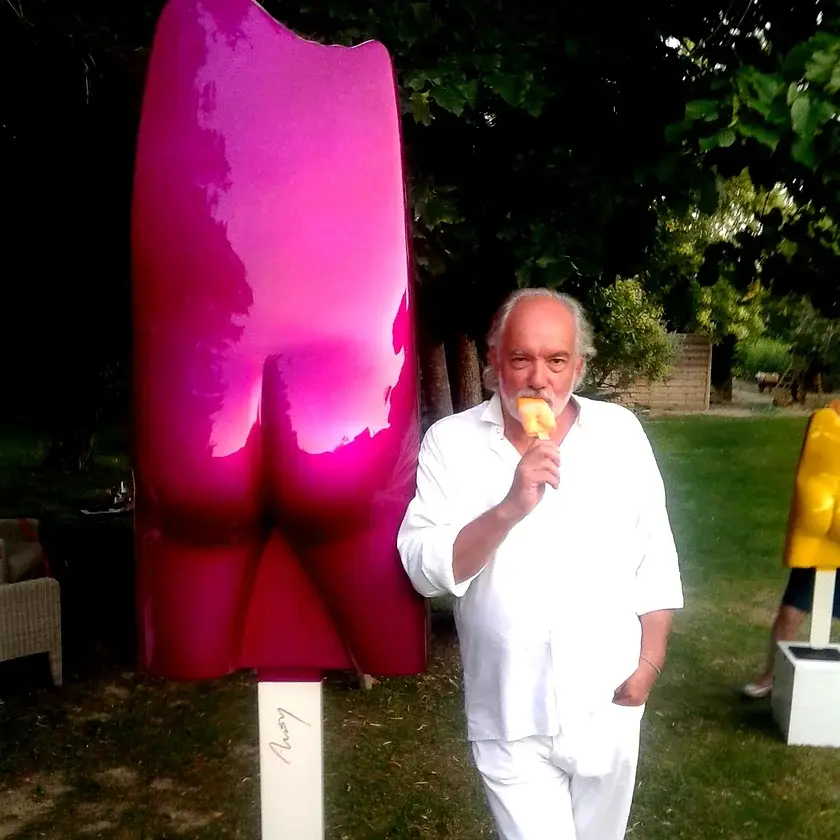It's undeniable that color in sculpture has played a crucial role in its evolution, particularly in the context of Pop Art. There's no doubt that it was color that radically transformed the artistic approach to materials and bright hues. Classic white sculpture expresses purity of form and the quest for the ideal. Pop sculpture emphasizes color as a central element. In this way, it is almost inseparable from the message of the work. Monochrome sculpture is often perceived as timeless and noble. Colored works made from modern materials, such as recycled resin, reveal a profound transformation in the way we understand art and the world around us.
From white sculpture to color: a paradigm shift
Traditionally, Western sculpture, particularly since antiquity, has been associated with materials such as white marble. Greek statues and Roman busts have shaped our perception of classical art as pure, timeless and elegant. This myth of immaculate white is misleading. Many of these ancient works were originally painted in bright colors that have faded over the centuries. So the idea of pure white sculpture is really just a later perception. What remains is an eighteenth-century neoclassical heritage that favored sobriety and perfection of form.
With the rise of pop art in the 1950s and 1960s, color in sculpture became an essential and asserted element. Artists such as Claes Oldenburg, Jeff Koons, Arson or Roy Lichtenstein . They reinvent three-dimensional art using bright, artificial colors. Often inspired by popular culture, comic strips and advertising. The choice of these garish, saturated hues is a strong aesthetic statement. The aim is no longer to sublimate the classical ideal, but to plunge straight into the everyday, the ephemeral and the commercial. Color in pop sculpture is not merely ornamental. It is an extension of content, a means of evoking the immediacy and accessibility of mass culture.
Colorful sculptures and recycled resin: a mirror of our times
Today, color in sculpture is widely used thanks to resin. Recycled resin has become a material of choice for many sculptors. The material is light, malleable and often more economical than traditional materials such as bronze or marble. It enables artists to produce large-scale works with almost unlimited flexibility in terms of shape and color. Beyond its practical advantages, the use of resin reveals much deeper contemporary issues. Particularly in the context of recycling,
Sculptures made from recycled materials reflect our society's heightened environmental awareness. Through their very materiality, they remind us of over-consumption and the accumulation of waste in a world saturated with plastic and industrial products. By transforming this waste into works of art, the sculptors participate in a reinvention of the concept of beauty. They give new life to materials once considered obsolete or disposable. This process gives the sculptures a conceptual depth, where color and texture become tools for rethinking our relationship with matter and the consumption cycle.
Take artist Saype, who uses biodegradable materials to create ephemeral sculptures. Or Aurora Robson, who sculpts monumental works from plastic waste. Using bright colors and recycled materials, these artists denounce the culture of waste. At the same time, they add a playful, aesthetic dimension to their creations.
The place of color in sculpture and the art market
The question of the place of color in recycled resin sculpture on the art market is complex and multifaceted. Traditionally, the art market favors works made from "noble" materials such as bronze or marble. These materials have traditionally been regarded as guarantees of quality and durability. However, the rise of ecological awareness and social criticism in contemporary art have overturned these hierarchies.
Works in resin, although initially perceived as less prestigious, have gained in artistic legitimacy. The choice of this material, particularly in the context of recycling, gives the sculptures an engaged dimension. They become anchored in the concerns of our time. What's more, the use of bright, unnatural colors is part of a pop aesthetic. As a result, they are accessible and instantly recognizable, appealing to a wider and often younger audience.
A future for color in sculpture
On the art market, color in sculpture made from recycled materials is enjoying a certain popularity. Contemporary art galleries and art fairs are exhibiting many of them. They are also prized by collectors and institutions wishing to associate their image with values of sustainability and innovation. However, there remains a tension between the material value of the work (often perceived as lesser because of the material used) and its conceptual and aesthetic value, which can be very high.
The challenge for these sculptures is to strike a balance between their aesthetic and critical dimensions. Their success on the market largely depends on the artists' ability to transcend the materiality of recycled plastic. Depending on whether they can turn it into a vehicle for emotion, reflection and beauty. In a world where mass consumption and ecological concerns are at the heart of debates, these colorful works in recycled resin have a key role to play, both artistically and in the marketplace.
Conclusion
In contemporary sculpture, color is an essential tool for conveying an immediate, popular and critical message. Sculptures in recycled resin, with their vivid hues and everyday materials, mirror a world preoccupied with ecology, over-consumption and the misappropriation of mass-produced objects. They stand in stark contrast to the tradition of white sculpture, associated with purity and eternity, and assert their place in a dynamic, constantly evolving present. On the art market, these works, at the crossroads of pop aesthetics and ecological commitment, occupy an increasingly legitimate place, reflecting both the challenges of our time and the new criteria for valuing contemporary art.


